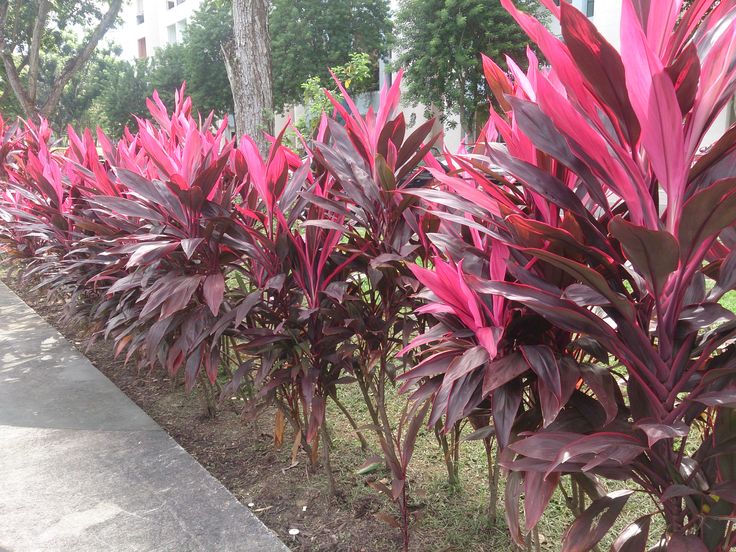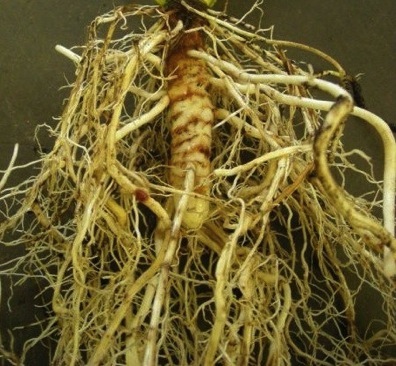Cordyline fruticosa: Food, Foliage, Booze
Simply called Ti (tee) Cordyline fruticosa spent most of its history with humans as a food, a source of alcohol, or a medicine. Now its foliage is in demand with many showy cultivars. Ti is probably native to southeast Asia and Papua New Guinea. It was carried throughout much of the Pacific by Polynesians who used the starchy rhizomes for food. An outdoor ornamental in warmer areas of the Earth today Ti is found naturalized in eastern Australia and many of the larger tropical Pacific islands including the Hawaii. It’s a common potted plant in cooler climates. The point is you should be able to find it nearly everywhere, often with other people taking care of it for you. And if you are so inclined you can even make a Hula skirt out of it.
Boiled roots taste like molasses and were used to make a beer that was reported to cure scurvy (but modern references to its nutrition are scarce.) Some say the Hawaiians learned to distill Ti beer into a stronger brew from convicts in Botany Bay, Australia. Young leaves are used as a potherb. Older leaves are used to wrap food, make clothes, rain capes and for thatch. Ti leaves are to wrap foods for grilling, steaming or baking. Dried leaves should be soaked to soften before using.
One word of caution. Don’t confuse the Ti with the Dracaena. Ti leaves have a petiole (stem) arching out from the trunk or branch. Dracaena leaves clasp the trunk or branch. Dracaena will also burn your mouth and hands.
Two species are regularly reported as food sources. C. fruticosa and C. australis. Cordyline (kor-dih-LYE-nee) means club-like, referring to the look of the roots. Fruticosa (froo-tee-KHO-sah) means fruit. Australis (oss-TRAY-liss) means southern.
Green Deane’s “Itemized” Plant Profile
IDENTIFICATION: Cordyline fruticosa is an evergreen shrub with a strong trunk which does not usually branch, 10 feet in height. Also a small house plant with colorful foliage, leaves 15-30 inches long, 4-6 inches wide, varying in color from shiny green to purple, red, yellow, purple and white. In mature plants, the leaves are tuft-like in appearance on the top of the stems, leaves along the stems with young pants. Flower fragrant, usually yellow or red, berry-like red fruit
TIME OF YEAR: Year round
ENVIRONMENT: Partial shade to nearly full sun, moist soil. Like humidity. Prefers water without Fluoride.
METHOD OF PREPARATION: C. australis: Young leaves and shoots eaten raw or roasted. Roots eaten or brewed after cooking. C. fruticosa. Roots cooked for food and brewing, young leaves cooked as a potherb. Also used to wrap food. The roots were slow roasted for days to get a molasses-like syrup which was then used for alcohol production. One way to use the leaf is to wrap food in it then cut the center rib out leaving two smaller wraps then cook (such as steam.)
This original article was first written in July 2011 by Green Deane.





Deane what about the whole debate of what is terminalis and what is fruiticosa…I thought “Red Sister” was C. terminalis but cvs. like ‘Peter Buck’ or ‘Black Magic’ were fruiticosa. Either way Red Sister above is edible? What about Hawaiin and Jamaican Green…omg I cant wait to blanch them and shock them to see if they keep their color…You rock Deane, thank you so much
Hey Deane, I am in the Austin ares (9a) and I will be growing this in several locations as food, but I wanna know if the berries are also edible…are they?
I also was wondering about the berries. Are they edible?
Dear Green Deane,
How long it takes to cook Ti root in a conventional oven? I want to try cooking it but not quite sure about the methods, despite your explanation.
Thanks in advance
Greetings from Brazil
Until soft…
sir,
are all showy cultivars of this plant edible according to your itemized list –
Are Ti berries edible?